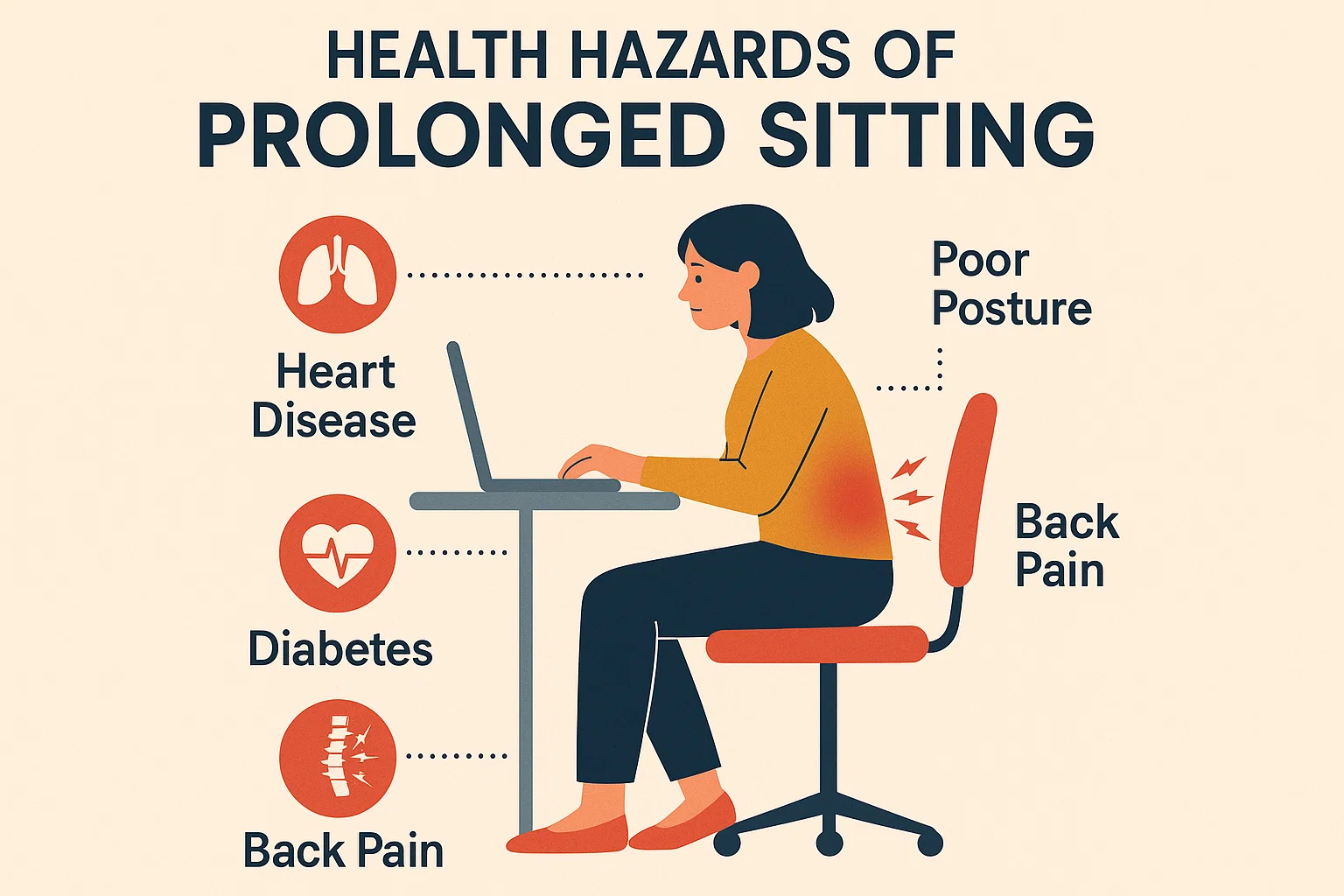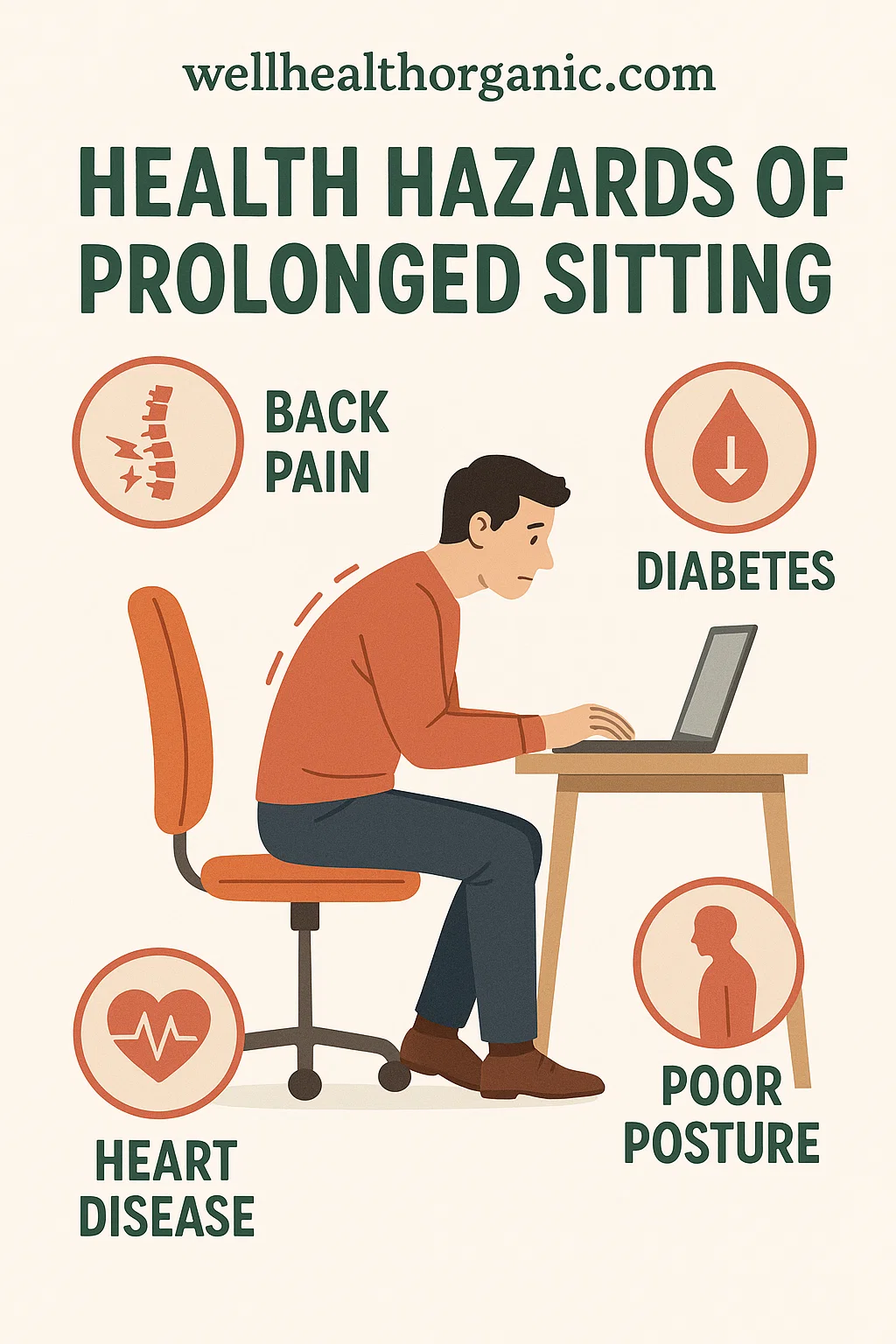In our modern world, many aspects of daily life revolve around sitting. Whether you’re working at a desk, watching TV, driving, or browsing your phone, it’s easy to spend hours without standing up or moving around. While sitting may seem harmless, prolonged sitting is now being labeled as the “new smoking” due to the serious health hazards it poses. According to medical experts and recent studies, excessive sitting can lead to multiple physical, mental, and metabolic problems.
In this article, we’ll explore the health hazards of prolonged sitting, how it affects your body, and what you can do to reduce the risks—even if your job or lifestyle demands extended hours of sitting.
Why Sitting Too Long Is Dangerous
Our bodies are built for movement. When we sit for extended periods, especially with poor posture or without breaks, it causes our muscles to weaken and our circulation to slow down. Over time, this can impact nearly every system in the body.
Let’s break down the major health issues linked with prolonged sitting:
1. Increased Risk of Heart Disease
Prolonged sitting slows blood circulation, leading to a buildup of fatty acids in the blood vessels. This can increase blood pressure and cholesterol levels. Studies show that people who sit for more than 8 hours a day without physical activity are more likely to suffer from cardiovascular diseases, including heart attacks and strokes.
2. Weight Gain and Obesity
Sitting burns fewer calories than standing or walking. Long hours of inactivity slow down your metabolism, making it easier to gain weight. Additionally, sitting for long periods often leads to mindless snacking or overeating—especially while watching TV or working on a computer.
Obesity itself is a major risk factor for diabetes, heart problems, and even cancer.
3. Type 2 Diabetes Risk
Prolonged sitting is directly linked to insulin resistance. Even a few hours of inactivity can lower your body’s ability to regulate blood sugar levels. This significantly increases the risk of developing type 2 diabetes, especially in people with a sedentary lifestyle and poor dietary habits.
4. Poor Posture and Musculoskeletal Issues
Most people don’t maintain proper posture while sitting. Over time, this can lead to chronic back pain, neck strain, and tight hips. Sitting puts pressure on the lower back, especially when slouched or leaning forward.
Common musculoskeletal issues include:
- Lower back pain
- Stiff shoulders
- Weak core and glutes
- Cervical pain or disc problems
5. Varicose Veins and Blood Clots
Long sitting, especially with crossed legs or in tight clothing, restricts proper blood flow in the legs. This can cause varicose veins (swollen, twisted veins) and increase the risk of deep vein thrombosis (DVT)—a potentially life-threatening condition where blood clots form in the veins, usually in the legs.
6. Mental Health Concerns
Sedentary behavior has been linked to anxiety and depression. Lack of physical movement reduces the release of feel-good hormones like serotonin and dopamine. People who sit for extended periods may also feel isolated, tired, or less motivated—especially if they’re not engaging in social or physical activities.
7. Digestive Issues
Sitting compresses your abdomen and can slow down digestion. This may lead to problems like:
- Bloating
- Constipation
- Heartburn or acid reflux
When you sit right after eating, your digestive system doesn’t function at its best. This can affect nutrient absorption and overall gut health.
8. Risk of Cancer
Emerging research has found a potential link between long sitting durations and increased risk of certain cancers such as:
- Colon cancer
- Endometrial cancer
- Lung cancer
Though the exact cause isn’t clear, experts believe it might be related to inflammation, hormonal imbalances, and weight gain from a sedentary lifestyle.
How Much Sitting Is Too Much?
While there’s no magic number, health professionals suggest that sitting more than 6–8 hours a day without any physical activity can pose health risks. The key issue isn’t just how long you sit, but also how frequently you break that sitting time with movement.
Tips to Reduce the Risks of Prolonged Sitting
Fortunately, you don’t need to quit your desk job or stop relaxing on the couch. Instead, build movement into your daily routine with these practical tips:
- Take Regular Breaks
Stand up and stretch every 30 minutes. Even 2–3 minutes of light movement helps improve circulation. - Use a Standing Desk
Alternate between sitting and standing while working. Some desks even allow treadmill walking while typing. - Stretch at Your Desk
Simple stretches for the back, neck, and legs can prevent muscle stiffness. - Walk More
Take the stairs, park farther away, or walk during phone calls. - Exercise Daily
Aim for at least 30 minutes of moderate physical activity such as walking, yoga, or cycling. - Mind Your Posture
Keep your back straight, shoulders relaxed, and feet flat on the floor. Use ergonomic chairs and desk setups. - Stay Hydrated
Drinking water not only benefits your health but also encourages you to get up more often to refill or use the restroom.
Final Thoughts
Prolonged sitting is a silent health hazard that affects millions of people across the world. From heart disease and obesity to mental health struggles and cancer risks, the consequences are real—but also preventable.
By understanding the risks and making small lifestyle changes, you can protect yourself from the harmful effects of sitting too long. Don’t wait until pain or illness strikes—get up, stretch, and move regularly.
For more wellness insights and natural health tips, visit wellhealthorganic.com and make your health a daily priority.










